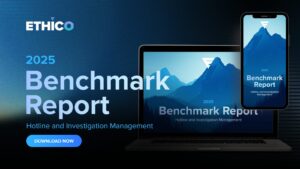Making Compliance Cool: Elevating E&C Influence 🕶️💣


Full Episode Available
WATCH ON-DEMANDWhat do trading card collections, pet competitions, and catchy jingles have in common? They’re all secret weapons in the arsenal of forward-thinking compliance professionals. This eye-opening session peels back the curtain on how entertainment value creates compliance programs that employees actually want to engage with. The presenters, Krista Wolff, Ronnie Feldman, and Nick Gallo, shared practical strategies, real-world examples, and evidence-based tactics for rebranding compliance programs, creating meaningful engagement, and fostering a culture where ethics and compliance are viewed as valuable business partners rather than obstacles. Their insights demonstrate how creativity, authenticity, and understanding business needs can dramatically increase program effectiveness.
This episode of The Ethicsverse encompassed theoretical frameworks on attention capture and information retention alongside tactical implementations including multimedia content creation, program rebranding, and metrics-driven assessment. Case studies from diverse industries illustrated successful implementation of these principles, with particular emphasis on leveraging minimal resources for maximum impact. The presenters provided compelling evidence that such approaches significantly increase engagement metrics, information retention, and program effectiveness, suggesting a new direction for compliance program development focused on experiential learning rather than traditional rule-based instruction.
Meet The Ethics Experts:
- Krista Wolff, Global Legal Compliance Education & Engagement Manager, Agilent Technologies
- Ronald Feldman, President & Creative Director, Learnings & Entertainments
- Nick Gallo, Chief Servant & Co-CEO, Ethico
Overcoming the “Office of No” Reputation
- The fundamental challenge for compliance programs lies in overcoming the negative reputation historically associated with compliance functions, often perceived as bureaucratic obstacles rather than helpful resources.
- People do not speak up when they’re bored, annoyed, or afraid, making this reputational barrier a significant hindrance to communication effectiveness.
- Acknowledging these stereotypes openly, often through humor, while simultaneously demonstrating how compliance enables business success is essential for transforming perceptions.
Pattern Disruption as a Strategic Communication Tool
- Breaking established patterns of communication represents a powerful behavioral science technique that can dramatically increase compliance message effectiveness.
- Introducing unexpected elements—whether through humor, multimedia, or novel formats—jolts the brain into heightened awareness and receptivity.
- Even small creative elements like surprising opening slides or unconventional metaphors can create sufficient novelty to pierce the veil of inattention that compliance professionals must overcome.
Rebranding Compliance Through Stakeholder-Aligned Identity
- Successful compliance programs are increasingly rebranding themselves with names, logos, and identities that resonate with their specific organizational culture and business focus.
- Examples include YUM Brands’ “TASTE” (Trust, Accountability, Support, Togetherness, Ethics), a plumbing company’s “Do It Right Rick” character, and Agilent’s science-themed “The Spark Starts With You” campaign.
- These rebrandings work by connecting compliance concepts to existing cultural touchpoints and business identities that stakeholders already value.
Leveraging Creative Formats for Maximum Distribution
- Short, entertaining, and shareable content formats significantly expand compliance message reach through secondary distribution channels without additional resource investment.
- When compliance professionals create brief, engaging content, these materials become amplified as managers voluntarily incorporate them into team meetings and ethics ambassadors share them proactively.
- These creative communications serve as pattern disruptors that open stakeholders’ minds to receiving the substantive compliance information that follows.
Humanizing Compliance Through Authentic Engagement
- Authenticity and personal connection represent powerful yet underutilized tools in compliance programs, as demonstrated through examples like Agilent’s trading cards and pet-based privacy campaign.
- When compliance professionals bring their genuine personalities and interests into their work, stakeholders respond with increased trust and engagement.
- This authenticity breaks down artificial barriers on both sides, creating opportunities for meaningful dialogue about substantive compliance topics.
Reimagining Traditional Compliance Assets
- Core compliance assets like codes of conduct can be transformed from bureaucratic necessities into engaging, useful tools through creative reimagining, as shown through examples of laboratory notebook formats for scientific organizations and character-driven presentations.
- These reimagined assets succeed by emphasizing usefulness rather than mere rule statements and incorporating visual elements that reflect the organization’s identity.
- The fundamental shift is moving from compliance documents as repositories of prohibitions to practical tools that help stakeholders navigate complex situations while accomplishing business objectives.
Training as Experiential Learning Rather Than Knowledge Transfer
- Effective compliance training requires a fundamental philosophical shift from attempting to transfer comprehensive knowledge to building practical skills and resource awareness.
- Agilent’s code of conduct training focused on teaching stakeholders where to find information and who to contact rather than attempting to cover all substantive topics.
- By creating an experience rather than a lecture, compliance programs can achieve higher engagement and better retention without requiring extensive time commitments.
Crowdsourcing as Compliance Engagement Strategy
- Involving stakeholders in compliance content creation represents a powerful engagement strategy with minimal resource requirements, as demonstrated by Agilent’s “Critter Cup” privacy awareness campaign.
- Such crowdsourcing approaches transform compliance from a one-way communication to a collaborative community activity where stakeholders become active participants and eventual advocates.
- These campaigns leverage stakeholders’ existing social networks and desire for recognition while building positive associations with compliance topics.
Low-Cost Creativity Through Adaptation and Technology
- Effective compliance communications need not require substantial budgets, as tools like Canva and smartphone video recording have democratized creative production.
- Adapting existing formats from popular media—such as “Mean Tweets” segments and game shows—provides ready-made creative frameworks that stakeholders already understand and enjoy.
- This approach allows compliance programs to focus their creative energy on content rather than format development, maximizing impact while minimizing required investment.
Measuring Effectiveness Through Engagement Metrics
- When Agilent implemented their reimagined code of conduct training, they achieved 6,000 completions in the first week and received 5,000 responses to an optional survey—evidence that creative approaches yield measurable results.
- Ninety percent of respondents indicated the training helped them better understand and apply the concepts, demonstrating that creative approaches enhance rather than detract from substantive learning.
- These metrics validate that investing in creativity and engagement fundamentally improves program effectiveness through increased attention, retention, and application of critical compliance concepts.
Closing Summary
This episode of The Ethicsverse ultimately demonstrated that making compliance “cool” is not merely an aesthetic choice but a strategic imperative for program effectiveness. By reimagining how compliance functions communicate, present themselves, and engage with stakeholders, compliance professionals can dramatically increase their influence and impact. The presenters encouraged compliance professionals to experiment, iterate, and embrace continuous improvement rather than perfection, emphasizing that even small creative steps can yield significant results. As compliance continues to evolve from a purely regulatory function to a true business partner, these innovative approaches provide a blueprint for building programs that not only ensure compliance but actively contribute to organizational culture and success through authentic engagement, creative communication, and genuine value delivery.






































